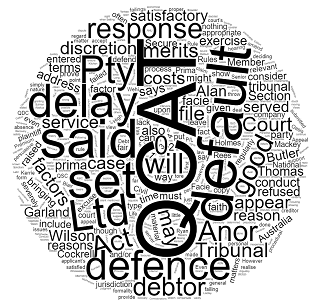Table of Contents
Toggle
Setting aside a default decision in QCAT is not as easy as you might think!
The Court will need to be persuaded of some or all of the following:
- Whether the respondent has raised a defence on the merits;
- Whether or not there is a good reason for the respondent’s failure to file a response;
- Any delay in bringing the application;
- Whether the applicant would be severely prejudiced if the judgment was set aside, in a way which could not be adequately compensated by, say, costs.
- The respondent’s conduct in the proceedings before and after judgment; and
- The respondent’s good faith.
If you need to set aside a default QCAT decision, then this article will give the information needed.
DEDICATED FOCUS – COMMERCIALLY MINDED – PROVEN RESULTS
OR CALL: 1300 545 133 FOR A PHONE CONSULTATION
Setting Aside a Default Decision in QCAT
Section 51 of the Queensland Civil and Administrative Tribunal Act 2009 (QLD) (“QCAT Act“) says:
The tribunal, on application by the respondent, may set aside or amend a decision by default on terms, including terms about costs and the giving of security, the tribunal considers appropriate.
The starting point for an application setting aside a default decision in QCAT is Garland and Anor v Butler McDermott Lawyers [2011] QCATA 151 where Justice Alan Wilson, President said:
Section 51 is in very similar terms to Rule 290 of the Uniform Civil Procedure Rules 1999. Decisions on rule 290 show that, among the factors relevant to the discretion arising under it are whether or not there is a good reason for the respondent’s failure to file a response; any delay in bringing the application; the respondent’s conduct in the proceedings before and after judgment; the respondent’s good faith; whether the respondent has raised a defence on the merits; and whether the applicant would be severely prejudiced if the judgment was set aside, in a way which could not be adequately compensated by, say, costs.
The factors to consider when setting aside a default decision in QCAT are:
- Whether the respondent has raised a defence on the merits;
- Whether or not there is a good reason for the respondent’s failure to file a response;
- Any delay in bringing the application;
- Whether the applicant would be severely prejudiced if the judgment was set aside, in a way which could not be adequately compensated by, say, costs.
- The respondent’s conduct in the proceedings before and after judgment; and
- The respondent’s good faith.
This article will explore these factors in more detail, or click for QCAT Applications.
Whether the respondent has raised a defence on the merits
Arguably the most important factor that a QCAT Member will consider in an application setting aside a default decision in QCAT, is whether the applicant has raised a defence on the merits.
In National Mutual Life Association of Australasia Ltd v Oasis Developments Pty Ltd [1983] 2 QD R 441 McPherson J said:
to set aside a judgment obtained against him in default of appearance is required to show by affidavit a defence on the merits, that is a “prima facie” or “substantial” defence … it will not be often that a defendant who has an apparently good ground of defence will be refused the opportunity of defending, even though a lengthy interval of time had elapsed in making his application provided no irreparable prejudice is thereby done to the plaintiff.
In Loanright Pty Ltd & Anor v Schollick [2017] QDC 178 when discussing this point the Court said:
The evidence put before this Court … is not just imprecise or vague, but is inexplicably lacking in support from direct evidence, when such evidence, if it existed, would appear to be available to the applicant. That is an important consideration, when the applicant is seeking an exercise of discretion to set aside a validly entered judgment by default.
What does Prima Facie Mean?
Butterworths Legal Dictionary (Third Edition) defines Prima Facie as:
Latin – at first sight; on the face of it.
A person who wants the Tribunal to set aside a regularly entered decision in default will be required to put evidence before the Tribunal of a genuine prima facie defence on the merits.
Evidence of a Prima Facie Defence
Subsections 28(3)(b) and (e) of the QCAT Act says that the Tribunal is not bound by the rules of evidence but must ensure, so far as practicable, that all relevant material is disclosed to it.
In Hamilton Roofing (Aust) Pty Ltd v Crocker & Build Restore Pty Ltd [2014] QCAT 211 Adjudicator Trueman said when discussing a prima facie defence:
… any alleged defence [the respondent] might have does not appear to be supported by the limited evidence attached to the submission or the court file.
Although no evidence is expressly stated in either the QCAT Act, the QCAT Regulations, or the QCAT Rules – Form 55, being the approved form for an application setting aside a default decision in QCAT, says:
Explain here why you want QCAT to set aside or amend the default decision. You should include here the reasons why you did not file a response to the original application that started the proceeding. You should also include details about what your proposed response would be if QCAT did set aside the decision. Your application may be refused if you do not include the information requested.
The salient information requested in the form are:
- Reasons why you did not file a response; and
- Details about what your proposed response would be.
This is consistent with what was said by Justice Alan Wilson, President, in Garland and Anor v Butler McDermott Lawyers [2011] QCATA 151.
Failure to include this information, and to produce evidence in support of this information, and the application may be refused by the Tribunal. Conversely, evidence which contradicts the information supplied by the debtor, could be used to defend the application setting aside a default decision in QCAT.
Whether or not there is a good reason for the respondent’s failure to file a response
A lot of the time, a debtor will allege that they were not served, or were not correctly served, or “had no idea” that a claim or application was on-foot.
An affidavit of service will usually successfully prove that the debtor was served. However, this is not always the case.
In Ryan v Wehi [2011] QCAT 376 the applicants an affidavit of service of the application was filed by an employee of the applicant’s solicitors deposing to the fact that he had sent a copy of the application by post to the respondents at their address. Kerrie O’Callaghan, Senior Member set aside a default decision because as Ms O’Callaghan said:
I was satisfied after hearing from the respondents at the directions that they did not receive a copy of the application although it was posted to their address. In view of the history of the matter I found it extremely unlikely that they would ignore an application if they had in fact received it.
Conversely, in Secure Investing Pty Ltd v Rees [2012] QCATA 28 Justice Alan Wilson, President said:
In the absence of any legally persuasive evidence that the application was not properly served, Secure Investing Pty Ltd has failed to show any basis upon which it is entitled to obtain leave to appeal … If Secure Investing Pty Ltd wishes to set aside the default judgement, it should bring the correct application … supported by evidence showing that the address in Mr Rees original application was wrong – e.g., ASIC records.
The distinction in the above two cases is personal service on a person, and personal service on a company, which should be noted.
Contumelious Disregard of the Process of the Court
Grand displays are also not uncommon. Debtor’s will often refuse to accept documents, and sometimes tear them up or throw them away.
Atkinson J observed in Yankee Doodles P/L v Blemvale P/L [1999] QSC 134 that:
The defendant must demonstrate ‘a very compelling reason’ for the failure to appear and that the criterion of a satisfactory explanation for failure to appear will be satisfied unless the failure to appear was in contumelious disregard of the process of the court.
Anecdotally, our process server managed to personally serve the director of a debtor company with a creditor’s statutory demand, when he was wheeling his bins out to the curb. Our process server identified the director of the debtor company and handed him the statutory demand stating what the documents were. The debtor then proceeded to open the lid of the bin and throw the documents inside.
Did not Know that the Documents were Important
In the QCAT Appeal jurisdiction in the matter of Cockrell v Mackey t/as Tablelands Premium Property [2014] QCATA 136 Justice Thomas, President considered the fact that the respondent tore up the application when served. Justice Thomas, President said:
Mr Cockrell failed to file a response because he tore up the copy of the application when it was served on him. Mr Cockrell’s lawyers submitted to the learned Magistrate that Mr Cockrell would have taken the time to reply to the application if he had known that it was a court document. That is not a credible excuse.
In Telco Australia Limited v Favell & Anor [2002] QSC 208 Holmes J considered the argument from the debtor that the debtor “did not realise the ramifications in failing to provide instructions (to his solicitor)”. Holmes J said:
I do not think that the applicant’s assertion that he “did not realise the ramifications in failing to provide instructions” provides, by any stretch of the imagination, a satisfactory explanation of his failure to defend. Mr Hack SC for the respondent submitted that that lack of any satisfactory explanation should, per se, be fatal to the application. As I indicated in argument, while that factor may be a powerful consideration in deciding whether judgment should be set aside, I doubt that it alone can be determinative, where, as here, there is no extreme delay and no suggestion of prejudice to the respondent. It is appropriate, in my view, to consider the applicant’s arguments as to the merits of his proposed defence.
Holmes J concluded, after considering if there was a good reason for the delay, and if there was a prima facie defence available:
… having regard to the absence of any satisfactory explanation for the delay in defending and the lack of any convincing case for the defence … the judgment should not be set aside. The application is dismissed.
If you can prove service, and prove that the debtor simply decided to do nothing with the documents, then you might be able to satisfy the tribunal that there is no good reason for the failure to file a response, however, this decision is discretionary, and to be read together with the other reasons from Garland and Anor v Butler McDermott Lawyers [2011] QCATA 151.
Any Delay in Bringing the Application
In Gatton & Laidley Real Estate v Hayes Views Pty Ltd [2017] QCAT 108 quoting the High Court of Australia in Aon Risk Services Australia Limited v Australian National University [2009] HCA 27 Adjudicator Anna Walsh said:
Two other factors may also influence the nature of the discretion: the first is the emphasis, in the QCAT Act, on requirements that the Tribunal act quickly, and with as little formality and technicality as is consistent with a fair and proper consideration of the issues before it. The second is the decision of the High Court in AON v ANU in which the Court said that questions of delay, and cost for society in general, are to be regarded as important considerations in the exercise of a court’s discretion to excuse procedural failings.
As previously mentioned in Ryan v Wehi [2011] QCAT 376 above, Kerrie O’Callaghan, Senior Member set aside the decision in default. Part of the ratio for the decision was that:
The respondents did not delay once they were aware that judgment had been entered. They made contact with the Tribunal and sought advice as to the appropriate method to deal with the decision which they wished to oppose.
Conversely, where no explanation for a delay is given, the decision to set aside a regularly entered decision may still be given. In Blair v Harbrew Pty Ltd [2013] QCATA 19 Justice Alan Wilson, President said:
Even though Mr and Ms Blair have not explained the delay, I accept that the exercise of the discretion in s 51 of the QCAT Act favoured setting aside the default decision.
In Paradise Produce NT Pty Ltd v Arnolds Fibreglass Repairs Pty Ltd [2010] QCATA 32 the President in the QCAT Appeal jurisdiction said:
[The Debtor] has simply failed to explain how or why it did not appear or deliver a response, or the delay in seeking to set the judgment aside … The application for leave … addresses none of these matters. Even so, for the reasons explored earlier, there is nothing in the applicant’s material which is even moderately persuasive that it can rely upon any of these factors; and, again, there is nothing to suggest the decision by default was not regularly obtained. For these reasons, the application for leave to appeal should be refused.
So again, the case law considers any relevant factual matters in relation to the factors setting aside a default decision in QCAT as per Garland and Anor v Butler McDermott Lawyers [2011] QCATA 151 with delay in bringing the application to set aside a default decision an “important consideration in the exercise of a court’s discretion to excuse procedural failings” but not in itself determinative.
Whether the applicant would be severely prejudiced
In Rosing v Ben Shemesh [1960] VicRp 28 the Full Court of the Supreme Court of Victoria said:
delay in itself would not be important, but delay prejudicing the other party, or delay enabling rights of third parties to intervene, would be material.
This case was then cited in National Mutual Life Association of Australasia Ltd v Oasis Developments Pty Ltd [1983] 2 QD R 441 along with Atwood v Chichester (1878) 3 Q.B.D. 722 amongst others as precedent for prejudice to the plaintiff / creditor / applicant. They said:
It is not often that a defendant who has an apparently good ground of defence would be refused the opportunity of defending, even though a lengthy interval of time had elapsed provided that no irreparable prejudice is thereby done to the plaintiff
Following this, in Crime and Misconduct Commission v Chapman & Anor [2011] QCAT 229 Mr James Thomas AM QC, Member said:
… the discretion is not to be trammelled, and exercises of this nature must be determined case by case according to recognised principles.
In Cockrell v Mackey t/as Tablelands Premium Property [2014] QCATA 136 Justice Thomas, President said:
In deciding whether to set aside a decision by default, the tribunal should consider … delay in filing a response, the reasons for the delay, and whether there is an arguable defence. The latter of those has been suggested to be the more important factor, however, risk of prejudice to the other party will also be considered.
Justice Thomas, President then went on to set aside the decision in default and said:
It is regrettable that Ms Mackey will be put to the inconvenience of a hearing, particularly given Mr Cockrell’s cavalier approach to the dispute, but she has suffered no real prejudice.
In Loanright Pty Ltd & Anor v Schollick [2017] QDC 178 Long SC DCJ said:
This application proceeded upon general consensus as to the applicable principles. Although it is necessary to have regard to whether or not there is any satisfactory explanation for the failure to defend and/or whether there has been delay in bringing the application, which considerations may particularly give rise to further considerations of prejudice to the respondent and such as might go beyond compensation in terms of costs
So, if an award of costs cannot compensate a party for any prejudice that party might have suffered, or is likely to suffer by the granting of the application to set the decision by default aside, then it is an important factor in the matrix of the other factors and considerations.
The Respondent’s Conduct in the Proceedings Before and After Judgment & the Respondent’s Good Faith
 The case law is reasonably silent on the type of “conduct” or type of “good faith” with may be considered in an application setting aside a default decision in QCAT.
The case law is reasonably silent on the type of “conduct” or type of “good faith” with may be considered in an application setting aside a default decision in QCAT.
As the decision in Garland and Anor v Butler McDermott Lawyers [2011] QCATA 151 says that “Section 51 is in very similar terms to Rule 290 of the Uniform Civil Procedure Rules 1999”. However, the decisions under rule 290 focus primarily on”
- Whether or not the defendant has given a satisfactory explanation for its failure to appear; and/or
- Whether or not there has been any delay in making the application; and/or
- Whether or not the defendant has a prima facie defence on the merits to the claim on which the judgment is founded.
Debt recovery and insolvency professionals can certainly understand the types of conduct and lack of good faith that this decision refers to. We see this type of conduct every day:
- Debtors moving house or interstate and attempting to disappear;
- No address for service or a purposefully incorrect address for service;
- Attempting to “negotiate” with the debtor and defaulting numerous times again and again;
- And so on… all the while the costs for the creditor continue to go up and up.
Other Considerations when Setting Aside a Default Decision in QCAT
Section 3 of the QCAT Act says:
The objects of this Act are … (b) to have the tribunal deal with matters in a way that is accessible, fair, just, economical, informal and quick
This section should also be a consideration when setting aside a default decision in QCAT or objecting to setting aside a default decision in QCAT.
In Secure Investing Pty Ltd v Rees [2012] QCATA 28 Justice Alan Wilson, President said:
… Section 51 of the QCAT Act … should be construed in light of requirements in the QCAT Act that the Tribunal must exercise its jurisdiction with as little formality and technicality as is consistent with the fair and proper consideration of the issues before it.
In Durrand and Anor v Karaolis and Anor [2012] QCATA 182 Justice Alan Wilson, President said:
The Queensland Parliament has made it clear, in the QCAT Act that so far as possible minor civil disputes of this kind are to be resolved by a simple procedure which is speedy, inexpensive and final.
Other Cases to Read
- Brewster t/a PRD Nationwide v de Abaitua [2010] QCATA 25;
- Corry v Skobla [2011] QCATA 101;
- Danes v Sulman [2012] QCATA 81;
- Johnson v Unicom Santronic Importers and Wholesalers [2011] QCATA 39;
- Kitchen v Lloyd [2010] QCATA 102;
- London v Oliver [2013] QCAT 529; and
- MVP Investments Australia Pty Ltd v Van Rooy [2010] QCATA 35.
DEDICATED FOCUS – COMMERCIALLY MINDED – PROVEN RESULTS
OR CALL: 1300 545 133 FOR A PHONE CONSULTATION








